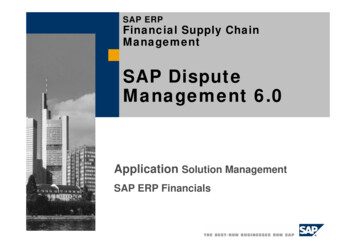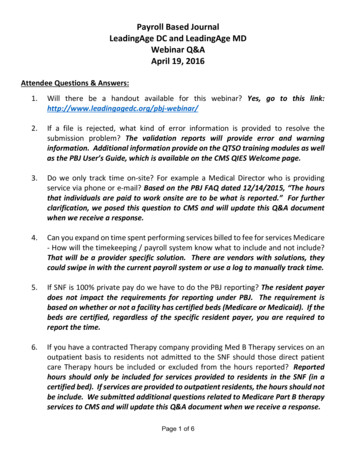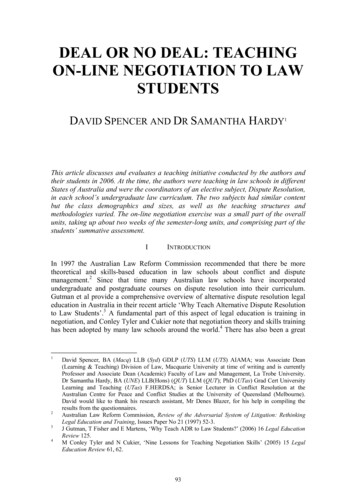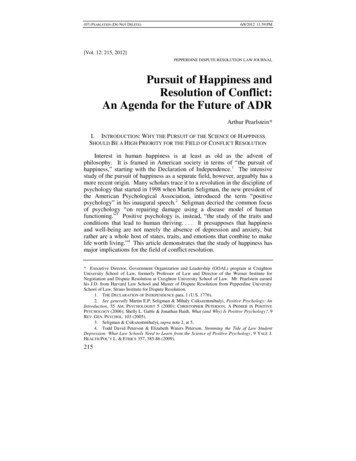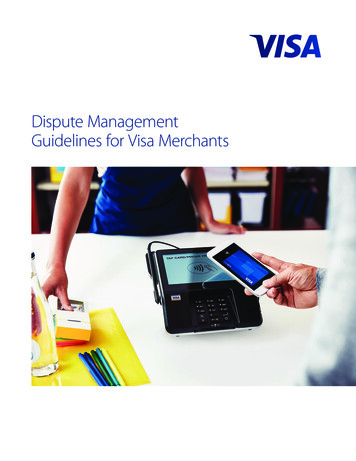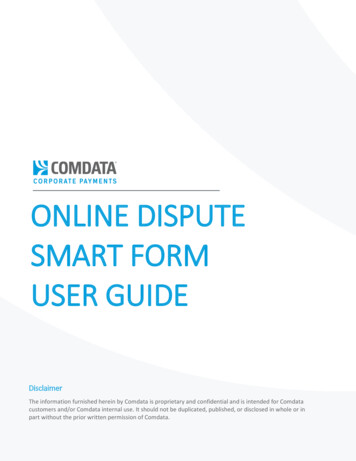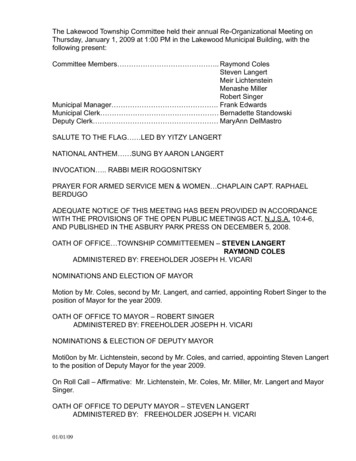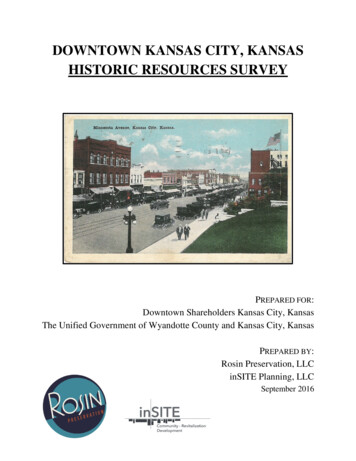
Transcription
Informal Dispute ResolutionRules, Process, and Case Theory
The Rules KSA 39-947a and KAR 26-39-438 through 440 provide thestatutory and regulatory framework for the IDR process. The CMS SOM and supporting S&C memos provide theoverarching rules for the IIDR process, but theimplementation of the IIDR is done through state policy asapproved by CMS.
IDR Request Any deficiency written by KDADS can be disputed in the IDRprocess. Instructions for requesting and IDR can be found in the letterprovided by KDADS at the time they formally exit. The request must be made in writing, within 10 calendar days ofthe survey exit. Request must include: A statement requesting either an in person, or phone conferenceIDR. Identification of the deficiencies in dispute. 5 hardcopies of your argument and any supporting evidence you wantthe panel to review.
IDR Request The exit letter will provide a contact name and address tosend the IDR request. Currently requests are sent to; Commissioner Thurness612 South Kansas AvenueTopeka, KS. 66603*Request for IDR or IIDR will not postpone imposition of anypenalties assessed for deficiencies being disputed.
IIDR Request CMS requires states to have an IIDR process in place for nursing homes to dispute deficiencies which resulted in the imposition ofcivil money penalties.The opportunity for an IIDR will be included in a letter fromCMS when CMS imposes a CMP and determines a facility iseligible for the IIDR.Request for IIDR must be made similarly to IDR, within 10calendar days from the offer made by CMS.The CMS letter typically comes out after the KDADS letter.CMS does not allow deficiencies to be disputed in both the IDRand IIDR. Facilities must choose one method or the other.
The Panels The IDR panel consists of two provider representatives, usuallyAdministrators or DONs that are not in the same market/region as thefacility disputing the tag.Third panel member is a survey and certification employee, who doesn’thave direct oversight over the provider, or the panel members. The IIDR panel consists of two provider reps, and “a person withexpertise in CMS policies and procedures and the SOM, who is notemployed by the KDADS survey and certification division.” This personcan be employed by other divisions of KDADS.KDADS has been using former regional managers, and KDHE employees fromthe non-LTC survey and certification division.
The Panels KDADS typically convenes IDR and IIDR panels one day amonth. KDADS distributes copies of the facility request, the facilityargument, and supporting evidence to the panel members inadvance of the IDR. An IDR panel will typically review 3-5cases each time.
The Panels The day of the IDR, the panel members are provided a brief onthe process, the rules regarding what can and can’t be disputed,the authority and limits of the panel, and a chair is selected to runthe meeting. The chair runs the meeting and uses the following guidelines tofacilitate the discussion. The chair typically asks the state to provide their argument first, withthe facility presenting second. The chair will ask the participants refrain from speaking out of turn,“cross examining,” or asking the other party follow up questions. Allfollow up and questions will be reserved for the panel members.
Delete, Reduce, Uphold Following the conclusion of the panel hearings, the paneldeliberates and offers its recommendation. The recommendationis made in writing and includes a summary of the reasoning. If consensus is not reached, the dissenting opinion can also writetheir reasoning in the summary. KDADS Secretary is ultimately responsible for deleting, reducing,or upholding the deficiencies. The Secretary does read andconsider the opinions contained in the panel’s recommendationsprior to issuing their decision. Regardless the outcome of an IDR,thoughtful arguments made in the IDR can broaden theunderstanding the Secretary has with respect to your issues, andcan impact policy.
Making your case The first opportunity to make your case is with your regionalmanager. More tags are deleted at the regional manager level thananywhere else in the process. The second opportunity to make your case is with the surveydirector. More tags are deleted by the survey director than theIDR process. These opportunities are best at correcting factual discrepancieswithin the 2567, identifying potential gaps in understanding, andidentifying documents or evidence showing compliance previouslymissed or not reviewed by the survey team.
Making your case – Listen first Speaking with your regional manager or the survey directorshould occur prior to submitting your request for IDR. The 2567 contains the basic argument the state will use during theIDR. If you present a colorful argument, or effectively cast doubton the surveyors findings, the panel will likely challenge the statewith follow up questions. Expect the state to have a goodresponse. The better you understand the arguments the state will make, thebetter you can tailor your argument to refute.
Making your case The panel is made of well meaning volunteers. They are busy justlike you. Your ability to communicate your case completely andconcisely is critical. The timeline for submitting your evidence package is short. Youneed to send all the pertinent evidence to support your argument,without drowning the panel members in reams of paper they willhave to make sense of. The panel will use the CMS SOM as their guide to determine theirrecommendation. It is recommended that you use the SOM as thebasis for your dispute.
Making your case The components of your evidence submission should mirror thecomponents of the state’s investigation. Assemble all the followingthat support your case. AssessmentsCare PlansNursing notesStaff and resident/family statementsOther items pertinent to verifying your compliance with the SOM.A narrative that describes how the facility was in compliance inaccordance with the language of the SOM.
Example: Elopement 75 year old female with BIMS of 13 is found by an employee coming onshift in the parking lot of the nursing home. It was 78 degrees outside,she had a lightweight blouse, trousers, sunglasses and a hat on. Whenasked where she was going, she stated she just wanted to go for a walk.The nursing home is located on a main road in town, with speed limit of40 mph. The employee brought the resident back inside and awanderguard was promptly placed on the resident. The investigationidentified the door locks and alarms had been checked the day beforeand were all functioning, checked again immediately following theevent. It was determined that the resident had exited behind an elderlyvisitor to the facility. Surveyor wrote F 323 at a “J.” Why?
Example Are we going to IDR? What’s our case theory? What evidence do we need to submit?
Appendix Q- Determining “IJ” 3. Culpabilitya. Did the entity know about the situation? If so when did the entity first become aware?b. Should the entity have known about the situation?c. Did the entity thoroughly investigate the circumstances?d. Did the entity implement corrective measures?e. Has the entity re-evaluated the measures to ensure the situation was corrected?Note: The team must consider the entity’s response to any harm or potential harmthat meets the definition of Immediate Jeopardy. The stated lack of knowledge by theentity about a particular situation does not excuse an entity from knowing andpreventing Immediate Jeopardy. The team should use knowledge and experience todetermine if the circumstances could have been predicted. The Immediate Jeopardyinvestigation should proceed until the team has gathered enough information toevaluate any prior indications or warnings regarding the jeopardy situation and theentity’s response. The crisis situations in which an entity did not have any priorindications or warnings, and could not have predicted a potential serious harm, arevery rare.
Example- You’re the Panel Reduce Delete or Uphold?
Final thoughts Be prepared-know the 2567, the SOM, and all the facts for andagainst the deficiency. Use questions to challenge the assumptions For facilities, ask many questions of the regional and director prior to theIDR. For panel members, ask questions to challenge both parties on the holesin their arguments. Use questions to challenge the state on interpretations they have madewhich may not be fully supported by the SOM, or which neglect portionsof the SOM in favor of others. Get all the evidence!
Questions?
IIDR Request CMS requires states to have an IIDR process in place for nursing homes to dispute deficiencies which resulted in the imposition of civil money penalties. The opportunity for an IIDR will be included in a letter from CMS when CMS imposes a CMP and determines a facility is eligible for the IIDR. Request for IIDR must be made similarly to IDR, within 10
